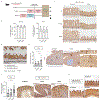Short-term post-fast refeeding enhances intestinal stemness via polyamines
- PMID: 39169180
- PMCID: PMC12103248
- DOI: 10.1038/s41586-024-07840-z
Short-term post-fast refeeding enhances intestinal stemness via polyamines
Abstract
For over a century, fasting regimens have improved health, lifespan and tissue regeneration in diverse organisms, including humans1-6. However, how fasting and post-fast refeeding affect adult stem cells and tumour formation has yet to be explored in depth. Here we demonstrate that post-fast refeeding increases intestinal stem cell (ISC) proliferation and tumour formation; post-fast refeeding augments the regenerative capacity of Lgr5+ ISCs, and loss of the tumour suppressor gene Apc in post-fast-refed ISCs leads to a higher tumour incidence in the small intestine and colon than in the fasted or ad libitum-fed states, demonstrating that post-fast refeeding is a distinct state. Mechanistically, we discovered that robust mTORC1 induction in post-fast-refed ISCs increases protein synthesis via polyamine metabolism to drive these changes, as inhibition of mTORC1, polyamine metabolite production or protein synthesis abrogates the regenerative or tumorigenic effects of post-fast refeeding. Given our findings, fast-refeeding cycles must be carefully considered and tested when planning diet-based strategies for regeneration without increasing cancer risk, as post-fast refeeding leads to a burst in stem-cell-driven regeneration and tumorigenicity.
© 2024. The Author(s), under exclusive licence to Springer Nature Limited.
Conflict of interest statement
Declaration of interests
The authors declare no competing interests.
Figures













Update of
-
Post-fast refeeding enhances intestinal stem cell-mediated regeneration and tumourigenesis through mTORC1-dependent polyamine synthesis.Res Sq [Preprint]. 2023 Jan 10:rs.3.rs-2320717. doi: 10.21203/rs.3.rs-2320717/v1. Res Sq. 2023. Update in: Nature. 2024 Sep;633(8031):895-904. doi: 10.1038/s41586-024-07840-z. PMID: 36711807 Free PMC article. Updated. Preprint.
References
Methods references
MeSH terms
Substances
Grants and funding
- R00 DK123407/DK/NIDDK NIH HHS/United States
- R01 DK126545/DK/NIDDK NIH HHS/United States
- P30 CA014051/CA/NCI NIH HHS/United States
- R01 CA257523/CA/NCI NIH HHS/United States
- U01 CA250554/CA/NCI NIH HHS/United States
- MR/X020258/1/MRC_/Medical Research Council/United Kingdom
- OT2 CA297570/CA/NCI NIH HHS/United States
- R01 DK126969/DK/NIDDK NIH HHS/United States
- U54 CA224068/CA/NCI NIH HHS/United States
- R01 DK133919/DK/NIDDK NIH HHS/United States
- R01 CA034992/CA/NCI NIH HHS/United States
- R01 CA211184/CA/NCI NIH HHS/United States
LinkOut - more resources
Full Text Sources
Medical
Molecular Biology Databases

